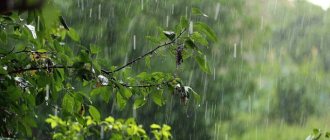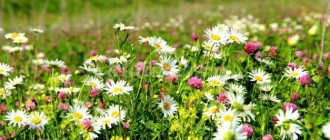Summer walk in the preparatory group
Summary of a summer walk for preschool children 6-7 years old on the topic “Wind Observation”
Description : I offer a scenario for a summer walk for preschool children 6-7 years old. It will be useful for educators. Purpose : to clarify the idea of wind. Objectives: - expand knowledge about the diversity of inanimate nature, air, and the natural phenomenon “wind”; develop the ability to make basic conclusions about interactions and relationships in nature; - develop observation, attention, visual memory. Progress of the walk: Riddle. I ran along the meadow path - the poppies nodded their heads, I ran along the blue river - And the river became pockmarked. The clouds are driving, howling, howling. Prowls the world, sings and whistles. (wind) Conversation. — How can you determine whether there is wind? -Which one - weak or strong. - By what signs did they find out about this? (tree branches sway - strong wind, blades of grass sway slightly - weak). The wind can be different: in summer it is warm, in autumn and winter it is cold and piercing. In summer it blows cool air over the body. In winter and autumn, you want to hide from it as quickly as possible. Invite children to be silent and listen to the sounds of nature. Share your impressions. Experience: Lower the boats into the water. Children blow on the boats, they float. This is how real ships move thanks to the wind. What happens to a ship if there is no wind? What if the wind is very strong? A storm begins, and the boat may suffer a real wreck (the children can demonstrate all this). Signs: the sky at sunset is light pink or golden - good weather; the wind changes direction clockwise and subsides in the evening - good weather. Sayings and proverbs: “Spring is red, but summer is miserable” Poems JULY In this month, no matter the year, the heat floats above the earth. And it was not for nothing that the first hare litter hid in the bushes. Didactic game “Add a syllable” Goal: to develop phonemic awareness and quick thinking. Progress of the game: the teacher names one syllable and throws the ball. The one who catches it must complete it to form a word, for example: wind, sun, book. The person who completes the word throws the ball to the teacher. Outdoor game “Cossacks - Robbers” Purpose: to introduce the folk game; develop dexterity. Progress of the game. The "Cossacks" find a place - a "dungeon", while the "robbers" hide. The “robber” is considered caught if the “Cossack” touches him with a twig (“whip”). A “robber” who has been captured has no right to escape. All prisoners are brought to a “dungeon” guarded by a “Cossack”. Rogues can free their comrades by touching them. But if at this moment they themselves are caught by the “Cossack watchman”, then they will also end up in “dungeon”. The game is considered over when all the “robbers” are in the “dungeon”. Fun game “Count with your feet.” (individual work) Goal: development of the eye. Progress of the game: a square with a side equal to 1 meter is drawn on the asphalt. 2 children stand in the center of the squares, they are blindfolded and asked to follow the exact commands: “Circle”, “6 steps forward”, “2 jumps on the left foot to the right”, “Circle”, “Now return to the square and shake hands " The one who is closest to his place wins. Labor on the site . Water the flowers together with the children, remind them how to pour the water, how to direct the stream so as not to wash away the inhabitants of the flower beds: various insects live on the flowers, and by watering the flowers from above, we wash them away and many die in the water. Independent games with sand and outdoor materials.
We recommend watching:
Organization and methodology for conducting a walk in kindergarten Summer walk in the senior group Organization of observations in nature in late autumn in the middle group of preschool educational institutions Summer walk in the preschool educational institution
Similar articles:
Organization of a walk in the junior group according to the Federal State Educational Standard
Observations of wildlife in the younger group of kindergarten
Observations of inanimate nature on a walk in the younger group
Observations of the work of adults in the younger group
Observations of street life. Junior group
Summary of a targeted winter walk in the middle group of kindergarten
Summary of a targeted walk in the preschool educational institution “Winter Wind”
Goal: To form in children elementary ideas about the wind. Objectives: 1. Continue to acquaint children with seasonal changes in living and inanimate nature; 2. Teach children to observe phenomena and objects of living and inanimate nature; 3. To consolidate children’s knowledge about winter, about the winter features of nature; 4. To form in children elementary ideas about wind as a phenomenon of inanimate nature; 5. Develop children's thinking, imagination, observation, attention; 6. Develop dialogical speech in children; 7. Enrich and activate children's vocabulary; 8. Strengthen in children the ability to act in accordance with the text, hear, listen and remember artistic words; 9. Foster children’s interest in learning; 10. Cultivate in children an interest in natural phenomena and experimentation. Preliminary work: - Examination of illustrations about winter, the poster “Winter Forest”, “Trees in Winter Dress”; — Conversations: “What kind of wind is there?”, “What does the wind do”; — Experiments: “A breeze is blowing”, “Strong or light breeze”; — Didactic exercises: “Strong-weak”, “Light-heavy”; - Reading stories, fairy tales, poems about the wind; - Mobile and finger games. Equipment: Plumes, red ribbon. Progress of the walk: (The walk is carried out on the territory, playground, site of the kindergarten. Children stand near the trees in a semicircle) Educator: Guys, look how beautiful it is all around! Winter has completely taken over nature. There is white fluffy snow on the paths, trees, and roofs, which glistens and sparkles in the sun. Look, children, how interesting it is to watch snowflakes fall. Either they fall slowly, in soft flakes, or they are driven by the wind, and the snowflakes scatter in different directions. Reading the poem “In white velvet...” In white velvet there is a village, And fences and trees. And as the wind attacks, This velvet falls. Educator: What is it like, the wind? Conversation Questions for the conversation (expected answers from children): - Do you know what wind is?.. (Children) (This is the movement of air); — How can you create artificial wind? ... (You need to make the air move, for example: wave your hand, blow on each other, wave a fan, play with plumes); - Why is the wind called invisible?.. (The wind cannot be seen, it can only be felt); - What kind of wind can there be... (Strong, weak, cold, angry, prickly). - How can you find out if the wind is blowing outside?.. (If the branches of the trees sway, it means there is wind). Educator: Guys, look at the trees. The wind loves to play with trees. He “grabs” them by the tops of their heads and shakes off the snow and frost from them. And then it circles and flies through the snowdrifts. He picks up an armful of snow and covers the bush to the very top. Reading the poem by S. Marshak “The winds blow in February” The winds blow in February, The chimneys howl loudly. It rushes along the ground like a snake, Light drifting snow. Sedentary game “Transform” Purpose: To strengthen children’s ability to act in accordance with the text. Equipment: Magic wand Educator: I have a magic wand - a lifesaver. She can turn you into anyone: Chicky - chicky - chicky - chickalochka, Game - transformer. Turn around yourself and turn into trees! (Children turn into “trees”) Our legs are roots, (Children stomp on the spot) Our torso is a trunk, (Children make circular movements with their torsos) Our hands are large branches, (Children raise their hands up) Our fingers are small twigs! (Children spread their fingers) A light breeze blew. Small, thin branches on the trees swayed. (Children move their fingers) The wind increased. Large branches trembled and swayed. (Children move their hands) The weather has completely deteriorated, a strong wind is shaking the branches of the trees, bending their trunks, bending their crowns to the ground. (Children swing their arms, lean from side to side) But the wind died down. The trees are resting from the storm. (Children straighten up, move only their fingers and arms) (Teacher waves his wand) Let the trees become children again! Educator: The winter wind is cold, icy, prickly. Animals and birds hide from the strong wind. How do you guys escape the wind? (Children's answers) Educator: In windy weather, you need to fasten all the buttons. Zippers must also be closed. Then the wind will not get under your clothes, and the walk will become pleasant and useful. And also, in order not to freeze, you need to move actively. It's time for us to play! Outdoor game “Two Frosts” Goal: The ability of children to run in different directions without bumping into each other and without being caught. Rules of the game: (The playground is divided into two parts by a red line made of tape) Children run to the other side of the playground, and the frosts try to freeze them and touch the children. Those affected by frost are considered frozen, i.e. caught. After two dashes, the drivers change. Start dashing only after finishing the words. How to play: All players are located on the same side of the court. The drivers - Frosts stand, turning their faces to the players, and say: We are two young brothers, Two frosts are daring. I am Frost - Red Nose, I am Frost - Blue Nose. Which one of you will decide to hit the road? The children answer together: We are not afraid of threats, And we are not afraid of frost! Educator: To avoid getting sick, you need to breathe properly in cold weather. Breathing exercise: “Oh, winter-winter” Purpose: To strengthen children’s ability to inhale air through their nose and exhale through their mouth. Educator: Inhale fresh air through your nose. Take a deep breath. Now exhale slowly and blow on the plumes. (The teacher reads a poem, and the children exhale slowly) Oh, winter, winter, you came with the frosts. The wind is howling, the blizzard is blowing, sweeping along the street. Reflection: What time of year is it now? Where is the snow? Why do snowflakes fly in different directions? What is the wind like in winter? What does the wind do to trees? How should you dress in winter?
We recommend watching:
Summary of a musical-themed lesson on the topic “How do birds live in winter?” in the middle group of a preschool educational institution Synopsis of an integrated lesson in the middle group on the topic: Winter Synopsis of a winter walk for children of the middle group Synopsis of a walk in kindergarten in the middle group: Winter fun
Similar articles:
Observation “Footprints in the snow.” Middle group
Walk observation in winter in the middle group. Winter clothes
Card index of walks in the middle group according to the Federal State Educational Standard for January with goals
Card index of walks in the middle group according to the Federal State Educational Standard for December with goals
Card index of walks in the middle group according to the Federal State Educational Standard for February with goals





